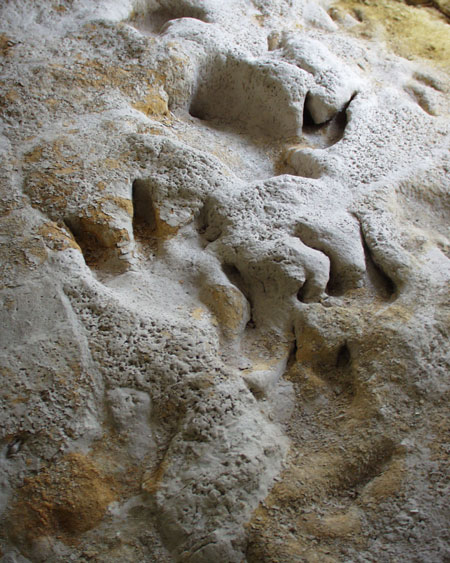 The Glen Rose Dinosaur Tracks, a famous set of tracks on display outside of the Texas Memorial Museum that are degrading and in need of repair.AUSTIN, Texas - Multinational energy company BP PLC has donated $40,000 to the Texas Natural Science Center at The University of Texas at Austin in support of the center’s capital campaign to save its one-of-a-kind display of fossilized dinosaur tracks from deterioration.
The Glen Rose Dinosaur Tracks, a famous set of tracks on display outside of the Texas Memorial Museum that are degrading and in need of repair.AUSTIN, Texas - Multinational energy company BP PLC has donated $40,000 to the Texas Natural Science Center at The University of Texas at Austin in support of the center’s capital campaign to save its one-of-a-kind display of fossilized dinosaur tracks from deterioration.
Fluctuating moisture levels inside and below the building that displays the famous Glen Rose dinosaur tracks outside of the Texas Memorial Museum are causing the rapid disintegration of the remarkable set of fossilized footprints. Analyses indicate that there are only months left to preserve them and move them into the environmentally safe confines of the Texas Memorial Museum.
“BP’s generous donation gives our campaign a timely push,” says Ed Theriot, professor of biology and director of the Texas Natural Science Center. “Deterioration of the tracks is ongoing and visible on a year-to-year basis.”
“BP is delighted to step up and support the preservation of this incredible natural treasure,” says James Dupree, BP’s Gulf of Mexico regional president. “The University of Texas at Austin continues to be one of our strongest university partners worldwide, and this important investment will help to preserve these marvelous tracks for generations of UT students and visitors.”
The company is a top employer of University of Texas at Austin graduates and has contributed more than $30 million to the university since the 1970s. BP has also invested more than $6 million in cutting-edge research at the university over the years.
The dinosaur tracks have been exhibited in a building outside of the Texas Memorial Museum on the campus of The University of Texas at Austin since 1941. The stone tracks were cut from the rocky bottom of North Texas’ Paluxy River, near the town of Glen Rose, and include a series of footprints from a sauropod and a theropod.
The tracks of the sauropod were the first scientifically documented, and are used by paleontologists as a “type specimen” — a standard for comparison with similar tracks. A species of sauropod that is thought to have made the tracks — Paluxysaurus jonesi — was declared the official State Dinosaur of Texas in 2009 by the state Legislature. Additionally, the positioning of the two sets of fossilized tracks has led scientists to speculate that the theropod was stalking the sauropod.
To preserve the tracks, the Texas Natural Science Center aims to treat and install them in a climate-controlled and environmentally safe exhibit gallery inside the Texas Memorial Museum’s Hall of Geology and Paleontology. The center’s plans include creating a new exhibit with a mural depicting the animals, along with signage with information about them, the age in which they lived, how they lived, and scientists’ speculations about the predator-prey actions indicated by the positioning of the tracks.
Total funding required for preservation and relocation of the rare tracks is estimated at $700,000. To learn more about the campaign and the tracks, visit savethedinosaurtracks.org.
For more information contact: Susan Romberg, Texas Natural Science Center, 512-232-5654.


















Comments